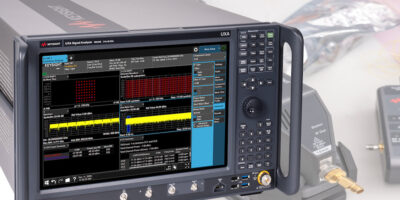To test the performance of millimeter-wave (mmWave) innovations in 5G, aerospace and defence and satellite communications, Keysight has developed the N9042B UXA X-series signal analyser which provides wide analysis bandwidth and deep dynamic range. It is designed to address difficult mmWave challenges including tight design margins and timelines, complex modulation and stringent standards.
“Understanding signal fidelity is critical to the performance of products in 5G, aerospace and defence, satellite and automotive radar markets,” observed Kiran Unni, vice president, industrial technologies practice, Frost & Sullivan.
“At mmWave frequencies, signals are more susceptible to impairments that affect the signal quality, such as IQ modulation errors, phase noise, distortion, signal-to-noise ratio, amplitude and phase linearity. For designers and manufacturers, addressing these challenges is crucial when characterising and testing the true performance of mmW products,” she added.
The N9042B UXA X-Series signal analyser ensures designs meet the latest standards with ready-to-use measurement applications and signal analysis software. It has an unbanded, pre-selected sweep from 2.0Hz to 110GHz and up to 11GHz of analysis bandwidth. The analyser tests the true performance of a 5G new radio (NR) transmitter with an advanced error vector magnitude (EVM). It also finds out-of-band emissions or spurs quickly in radar designs with superior swept displayed average noise level (DANL). The analyser develops high-throughput satellite communication designs with 4.0GHz of corrected analysis bandwidth.
“With the increasing demand for data, higher frequency and bandwidth, Keysight’s signal analyser and generator solutions embody our deep expertise in mmW design and measurements, for the latest 5G wireless, radar, aerospace defence, satellite and communications research,” said Joe Rickert, vice president and general manager of high frequency measurement R&D for Keysight’s communications solutions group.
To ensure designs meet the latest standards with ready-to-use measurement applications for cellular communication, wireless connectivity, and aerospace/defence, the company integrated PathWave X-Series measurement applications with the UXA X-Series signal analyser. These applications simplify complex tasks and deliver repeatable results. The 89600 PathWave vector signal analysis software comprises tools for demodulation and vector signal analysis. It offers support for over 75 signal standards and modulation types. It also enables customers to explore every facet of a signal and optimise their most advanced designs, added Keysight.
Testing 5G components and devices per the 3GPP 5G New Radio (5G NR) standard Releases 15 and 16 requires higher accuracy, sensitivity, and bandwidth capability in an analyser. To meet these parameters, the N9042B signal analyser tests the true performance of transmitter designs with error vector magnitude (EVM) and 5G NR signal analysis software which perform transmitter downlink and uplink measurements with one-button simplicity.
For satellite communication systems, customers need to characterise amplifiers and components at bandwidths wider than the target application. The N9042B UXA X-Series signal analyser provides a wide analysis bandwidth and unbanded, pre-selected frequency range to characterise the performance of satellite designs.
It also enables high levels of measurement accuracy with the Keysight V3050A signal analyzer frequency extender which is claimed to deliver unmatched measurement accuracy of wideband signals at very high frequencies. It provides sensitivity, unbanded and pre-selected frequency coverage up to 110GHz, high dynamic range and a seamless interface to the N9042B UXA signal analyser.
Keysight’s RCal receiver calibrator corrects system path losses and frequency responses up to 5.0GHz IF bandwidth without the need for an external vector network analyser, cabling and manual test-plane characterisation. The palm-sized RCal seamlessly transfers precision factory calibration data to the X-Series signal analyser over a USB connection.
A companion VXG microwave signal generator offers high output power with low phase noise and wide bandwidth for demanding wireless, as well as aerospace and defence applications. The VXG’s dual-channel architecture, quickly switches from blocker and interferer tests to dual channel MIMO and beam forming tests.







